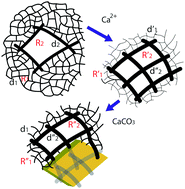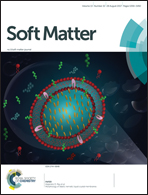Self-adaptive hydrogels to mineralization†
Abstract
Mineralized biological tissues, whose behavior can range from rigid to compliant, are an essential component of vertebrates and invertebrates. Little is known about how the behavior of mineralized yet compliant tissues can be tuned by the degree of mineralization. In this work, a synthesis route to tune the structure and mechanical response of agarose gels via ionic crosslinking and mineralization has been developed. A combination of experimental techniques demonstrates that crosslinking via cooperative hydrogen bonding in agarose gels is disturbed by calcium ions, but they promote ionic crosslinking that modifies the agarose network. Further, it is shown that the rearrangement of the hydrogel network helps to accommodate precipitated minerals into the network -in other words, the hydrogel self-adapts to the precipitated mineral- while maintaining the viscoelastic behavior of the hydrogel, despite the reinforcement caused by mineralization. This work not only provides a synthesis route to design biologically inspired soft composites, but also helps to understand the change of properties that biomineralization can cause to biological tissues, organisms and biofilms.



 Please wait while we load your content...
Please wait while we load your content...